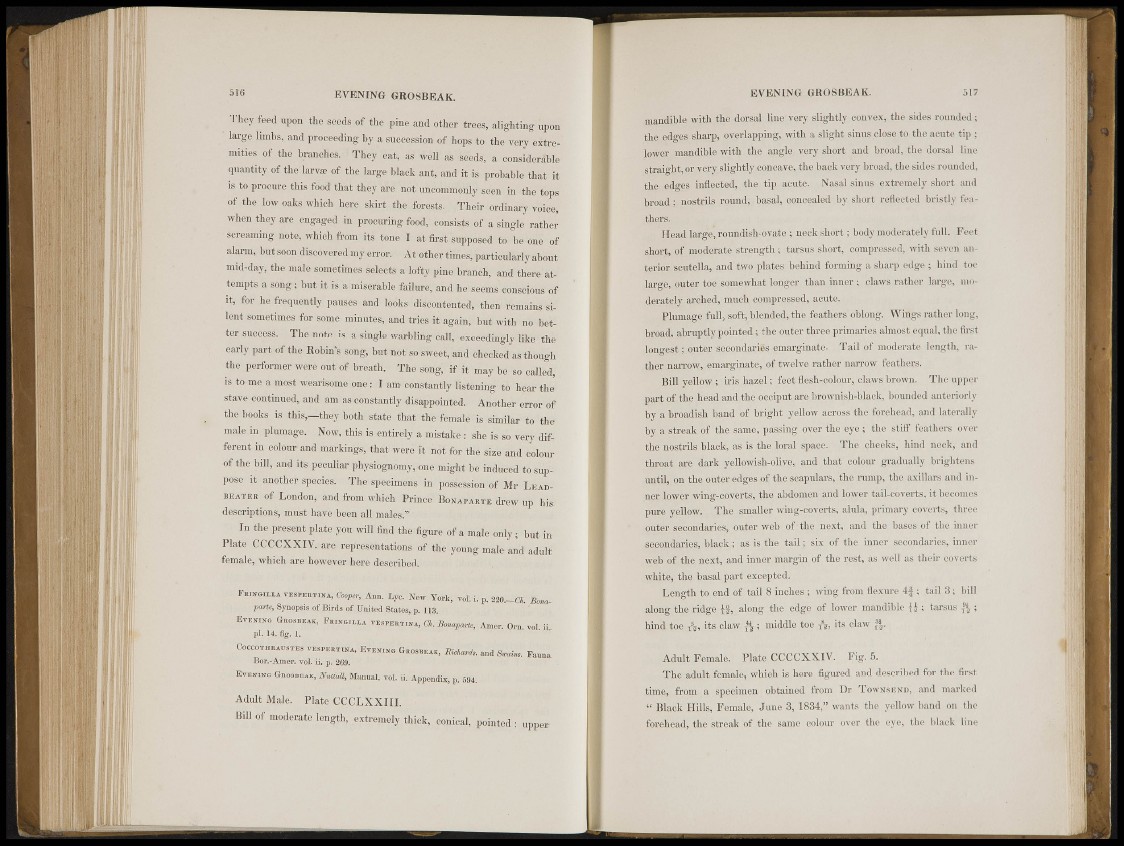
516 E V E N I N G GROSBEAK.
They feed ujòn the seeds.oS the pine,and other trees, alighting Sp-on
large limbs, and proceeding by a succession of hops Jtfijijfee very eltremities
of the brancli|| ' They eat, as well as -keeds, ¿tconsiderlble
quantity, qf_the larvae of the large black ant, and it ÌÉ- probable that it
is to procujS tiiis food that thè^ aJe Ipft'uncommoiily seen ;jm the tops
of the low oaks which herg start the $^s t s Their ordmary-foicei'
when they are engaged in procuring food, consists of a single rather
screaming" irpte, which from its! tone I at first supposed to be &iè of
alarm, butsoqttkdiscoveredmy errois At other tifies, particularly about
mid-day- the male som.aimqi,.select« a lofty pine branch, mid iBffifoi*
tempts a sosgft butgtls iUmìg®àble failure, and he seeing conscious of
it, fer helfr-equently pauses and looks discontented, then remains si-
•tent sometimes fer some, minutes, and trfasflj&gaia, but with no better
sueces-s. The^jlote^is a «ingle warbling call, exceedingly like the
early part of the Robin's song, but not so'sweet, Wd checked as though
the perfbrmer were oufroì fereatif The sobg, % i t ' ^ b é si, called,
is to me a most wearisome ®ie# I am- constantly «»toning to heap the
stave 'continued1,, tad am asleonstawtly disappointed. Another error of'
the books is. this,—ttey h'ctól state that the femalei! similar to 'the
maleiin plumage.. IJfiw, this is en&el | a mistake : s t e 'So very different
in colour-and markings, that weri'ft not for th^ siz'e and colour
of the b « and its peculiar physiognomy, one might be induced to suppi
®; it another sgbiesN The specimens in possession of Mr Lìad-
W e * of London,/ and from which Prince1 Bonapaute drew up his
descriptions, must have beer, all mài?«!*'-!.
' . In the present plate you will find the'fiÀÌSof a male o n l y b u t in
Plate ^ é C X X I V . Me representations' df the young male an3 adult
female, which: are however here described.
Bsmtei» iiftBEBi 1WA,:^^¡sm^^^È Toil, -'iste f ^ o r t èK; j^ìà
l-art'., Xy.-H.psis of liir,!« of l.uitwl Si««.«, p. 113.
E m » s Guosmak, vK8VHR.xr.\A, A.Bonayartc, Àmei, vol ii
COGCOTHHAUST'ES v i s P * * ™ , ® ^ tì««, an d ^
• ' ii. p.-269. •
Adult Malif' Plate eCCLXXXII.
Bill of moderate length, extremely thick, conical, pointed upper
E V E N I N G GROSBEAK. 517
mandible with the dorsal line' very slightly convex, the sides rounded ;
the edges sharp, overlapping, with a slight sinus close to the acute tip ;
lower mandible with the angle very short and broad, the dorsal line
straight, of very slightly concave, the back very broad, the sides rounded,
the- edge? inl!ect«d, the. tip acute. Nasal sinus extremely short and
broad: nostrils round, basal, concealed by short reflected bristly leathers.
Head large:,roundish-ovate ; nock short ; body moderately full. Feet
short, of mo.hjpate strength: tarsus short, compressed, with seven anterior
scutella, and two plates behind forming a sharp edge ; hind' toe
large, outer toe somewhat l'onger than inner ; claws rather large, moderately.
arched, much compressed, acute.
Plumage .full, soft, blspded, the feathers'oblong. Wings rather long,
broad, abruptly pointed; the outer three primaries almost equal, the first
longest; outer secondaries, emai'ginate. Tail of moderate length, rather
narrow , omarginuto, of twelve rather narrow feathers.
Bill yellow; iris hazel; feet flesh-colour, claws brown. The upper
part of the head and the. occiput are brownish-black, bounded anteriorly
by a broadish band of bright yellow aeross the forehead, and laterally
by a streak of the same, passing over the eye ; the stiff feathers over
the nostrils black, as is the loral space. The chucks, hind neck, and
throat are dark yellowish-olive, and that colour gradually brightens
until, on the outer edges of the scapulars, the rump, the axillars and inner
lower wing-coverts, the abdomen and lower tail-coverts, it becomes
pure yellow. The smaller wing-coverts, alula, primary coverts, three
outer secondaries,, outer web of the next, and the bases of the inner
secondaries, bliick ; as is the tail; six of the inner secondaries, inner
web of the next, and inner margin of the rest, as well as their coverts
white, the. basal part excepted.
Length to ciid o£,uiil 8 inches ; wing from flexure 4 j ; tail 3; bill
along the ridge ¡'i; along the edge of lower mandible ; tarsus ft ;
hind toe ft, its claw ft ; middle, toe A, its, claw
Adult Female. Hate CCCCXX1V. Fig. 5.
The adult female, which is here figured and described for the first
time,, from a specimen obtained from Dr Townsbnd, and marked
" Black Hills, Female, June 3, 1834," wants the yellow band on the
forehead, the streak of the same colour over the eye, the black line